| Bibliography for
HISTORY OF COMPUTING updated March 2015 |
 Thomas J. Misa
Thomas J. Misa Charles Babbage Institute University of Minnesota Minneapolis MN
55455
|
| Bibliography for
HISTORY OF COMPUTING updated March 2015 |
 Thomas J. Misa
Thomas J. Misa Charles Babbage Institute University of Minnesota Minneapolis MN
55455
|
Table of Contents
Chronology:
|
Topics and
Institutions:
SEE ALSO: History of Engineering | Global Culture | Military Microelectronics |
IEEE Annals of the History of Computing. (journal)
ON-LINE INDEX at <ieeexplore.ieee.org/xpl/RecentIssue.jsp?puNumber=85>
"Computing Then" -- Annals content on-line
Charles Babbage Institute (at University of Minnesota) -- research center for computer history:
Computer History Museum -- "the
world's largest history museum for preserving and presenting the
computing revolution and its impact on the human experience"
Heinz Nixdorf MuseumsForum
-- "not only the world's largest computer museum but also a
modern conference centre"
IEEE History Center -- historical exhibits on electrical engineering
Internet Society "Histories of the
Internet"
J.A.N. Lee's history of computing (at Virginia Tech) -- many files
Smithsonian's computer history collection
Ed Thalen's extensive list of on-line
historical documents <www.ed-thelen.org/comp-hist/on-line-docs.html>
Agar, Jon. The Government Machine: A
Revolutionary History of the Computer. MIT Press,
2003.
Braun, Ernest, and Stuart Macdonald. 1982. Revolution in Miniature: The History and Impact of Semiconductor Electronics. Cambridge University Press; 2nd ed.
Campbell-Kelly, Martin, and William Aspray. 1996/2004/2013. Computer: A History of the Information Machine. New York: Basic Books; 2nd and 3rd editions Westview.
Campbell-Kelly, Martin. "The History of the
History of Software." IEEE Annals of the History of
Computing 29 #4 (Oct.-Dec. 2007): 40-51. <UMN>
Castells, Manuel. The Rise of the Network Society. Cambridge, Mass.: Blackwell Publishers, 1996.
Castells, Manuel. End of Millennium; The information age, economy, society, and culture. Malden, MA: Blackwell Publishers, 1998.
Ceruzzi, Paul E. A History of Modern Computing. Cambridge: MIT Press, 1998; second edition 2003.
Chandler, Alfred D., Jr. Inventing the Electronic Century: The Epic Story of the Consumer Electronics and Computer Science Industries. New York: Free Press, 2001.
Chandler, Alfred D., Jr., and James W. Cortada, eds. A Nation Transformed by Information: How Information Has Shaped the United States from Colonial Times to the Present. Oxford University Press, 2000.
Edwards, Paul. "Making History" <www.si.umich.edu/~pne/PDF/makinghistory.pdf>
Edwards, Paul. "From 'Impact' to Social Process: Computers in Society and Culture" (1994) <www.si.umich.edu/~pne/PDF/impact.pdf>
"Frontline: Digital Nation." <www.pbs.org/wgbh/pages/frontline/digitalnation/view/>
[PBS Frontline 2010]
Goldstine, Herman H. The Computer from Pascal to von Neumann. Princeton: Princeton University Press, 1980, c1972.
Hashagen, Ulf, Reinhard Keil-Slawik, and Arthur L. Norberg, eds. History of Computing: Software Issues. Berlin/New York: Springer, 2002Headrick, Daniel R. When Information Came of Age: Technologies of Knowledge in the Age of Reason and Revolution, 1700-1850. Oxford University Press, 2002.
IEEE Annals of the History of Computing. (journal)
Online Index at <ieeexplore.ieee.org/xpl/RecentIssue.jsp?puNumber=85>
Mahoney, Michael
S. "The History of Computing in the History of Technology."
Annals of the History of Computing 10 #2 (1988): 113-125. <online> <UMN>
Mahoney, Michael S. "Finding a History for Software Engineering." Annals of the History of Computing 26 #1 (2004): 8-19. <online> <UMN>
Mahoney, Michael S. "The Histories of Computing(s)." Interdisciplinary Science Reviews 30 #2 (June 2005). <online>
Mahoney, Michael
S. Histories of Computing.
Harvard University Press 2011. [edited by Tom Haigh]
Misa, Thomas J. "Understanding 'How
Computing has Changed the World'." Annals of the History of Computing 29 #4
(2007): 52-63. <UMN>
Shurkin, Joel N. 1996. Engines of the Mind: The Evolution of The Computer from Mainframes to Microprocessors. New York: Norton.
Swedin, Eric
G., and David L. Ferro. Computers: The Life Story of a
Technology. Johns Hopkins University Press, 2007
"The Machine That Changed the World" <waxy.org/2008/06/the_machine_that_changed_the_world/>
Yost, Jeffrey R. The Computer Industry (Emerging Industries in the United States). Greenwood, 2005. Amazon.
Bromley, Allan G. "Charles Babbage's Analytical Engine, 1838" IEEE Annals of the History of Computing 4 #3 (1982); reprinted AHC 20 #4 (1998): 29-45. <UMN>
Cortada, James W. Before the Computer: IBM, NCR, Burroughs, and Remington Rand and the Industry They Created, 1865-1956. Princeton University Press, 1993.
Fuegi, John, and Jo Francis, "Lovelace & Babbage and the creation of the 1843 'notes'." Annals of the History of Computing 25 #4 (Oct-Dec 2003): 18-26. <Digital Object Identifier> <UMN>
Gibson, William, and Bruce Sterling. The Difference Engine: A Novel. Bantam, 1991. [The Ada Lovelace and Charles Babbage inspired prototype for "steam punk" movement]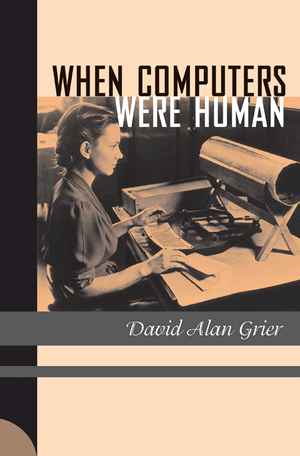 Grier, David Alan.
When Computers Were Human. Princeton: Princeton University
Press, 2005
Grier, David Alan.
When Computers Were Human. Princeton: Princeton University
Press, 2005Heide, Lars.
Punched-Card Systems and the Early Information Explosion,
1880–1945. Johns Hopkins University Press, 2009.
Hyman, Anthony. Charles Babbage, pioneer of the computer. Oxford: Oxford University Press; Princeton: Princeton University Press, 1982.
Hyman, Anthony (ed.) and H. W. (Harry Wilmot) Buxton. 1988. Memoir of the life and labours of the late Charles Babbage Esq., F.R.S. Cambridge: MIT Press; Los Angeles: Tomash, 1988
Jones, Douglas W. "Punched Cards" <www.cs.uiowa.edu/~jones/cards/> (Oct. 2003) [illustrated technical history; links to emulators; rentals; resources, e.g.: ]
Kistermann, F.W. "Hollerith punched card system development (1905-1913)." Annals of the History of Computing 27 #1 (2005): 56-66 <UMN>Steve Lubar's "Do not fold, spindle or mutilate": A cultural history of the punch card" Charles M. Province's "IBM Punch Card Systems in the U.S. Army" Sites illustrating Jacquard loom, and Herman Hollerith)
Maney, Kevin. The Maverick and His Machine: Thomas Watson, Sr. and the Making of IBM. John Wiley & Sons, 2003.
Pugh, Emerson W.,
and Lars Heide. "Punched Card Equipment." IEEE
STARS [2009] <online>
Punched card tabulating equipment, invented and developed by Herman Hollerith to process data from the United States Census of 1890, was the first mechanized means for compiling and analyzing statistical information. Through continual improvements, first by Hollerith and then by many others, punched card equipment created and expanded the worldwide information processing industry and continued to play a significant role in that industry for more than two decades after the first commercial electronic computers were installed in the early 1950s.
Pugh, Emerson W. Building IBM: shaping an industry and its technology. Cambridge: MIT Press, 1995.
Stein, Dorothy. Ada: A Life and a Legacy. Cambridge: MIT Press, c1985. [Lovelace, Ada King, 1815-1852.]
Swade, Doron. The Cogwheel Brain: Charles Babbage and the
quest to build the first computer. London: Little,
Brown, 2000.
Swade, Doron. "The construction of
Charles Babbage's Difference Engine No. 2." Annals of the
History of Computing 27 #3 (2005): 70-88. <UMN>
Yates, JoAnne. Control through Communication: The Rise of System in American Management. Johns Hopkins University Press, 1989.
Yates, JoAnne.
Structuring the Information Age: Life Insurance and
Technology in the Twentieth Century. Johns Hopkins
University Press, 2008.
Bennett, S. 1993. A History of Control Engineering 1930-1955. Peter Peregrinus.
Bowles, M. "Theory and Practice: Obstacles and Opportunities in the Development of the British and American Differential Analyzers." Annals of the History of Computing 18 #4 (1996). <UMN>
Care, Charles. Technology for
Modelling: Electrical Analogies, Engineering Practice, and the
Development of Analogue Computing. Springer, 2010.
Clymer, A.B. "The mechanical analog computers of Hannibal Ford and William Newell." Annals of the History of Computing 15 #2 (1993): 19-34. <UMN>
Holst, Per A. "George A. Philbrick and Polyphemus: The First Electronic Training Simulator." Annals of the History of Computing 4 #2 (1982): 143-156. <UMN>
Johansson, M. "Early analog computers in Sweden." Annals of the History of Computing 18 #4 (1996): 27-33. <UMN>
Karplus, Walter J. Analog Simulation. New York: McGraw-Hill, 1958.
Mindell, David. "Anti-Aircraft Fire Control at Sperry, 1925-1940." IEEE Control Systems (April 1995): 108-13.
Mindell, David. Between Human and Machine: Feedback, Control, and Computing Before Cybernetics. Baltimore: Johns Hopkins, 2002.
Owens, Larry. "Vannevar Bush and the Differential Analyzer: The Text and Context of an Early Computer." Technology and Culture 27 (1986): 63-95. <UMN>
Preston, Frank.
"Vannevar Bush's network analyzer at MIT." IEEE Annals of
the History of Computing (Jan-Mar 2003): 75-78.
Puchta, S. "On the role of mathematics and mathematical knowledge in the invention of Vannevar Bush's early analog computers." Annals of the History of Computing 18 #4 (1996): 49-59 <UMN>
Robinson, Tim.
Meccano
Computing Machinery. Differential Analyzer
bibliography 1
+ 2.
Small, J.S. "General-purpose electronic analog computing: 1945-1965." Annals of the History of Computing 15 #2 (1993): 8-18. <UMN>
The Analogue Alternative: The Electronic Analogue Computer in Britain and
the USA, 1930-1975. New York/London:
Routledge, 2001.
Tympas, A. "From digital to analog and back: the ideology of intelligent machines in the history of the electrical analyzer, 1870s-1960s." Annals of the History of Computing 18 #4 (1996): 42-48. <UMN>
Van den Ende, Jan. "Tidal calculations in the Netherlands, 1920-60." Annals of the History of Computing 14 #3 (1992): 23-33. <UMN>
Williams, Michael. "Differential Analyzers." IEEE STARS [2010] <online>
Some of the most difficult problems in science and technology involve solving equations relating to complex physical situations such as predicting the heights of tides, designing antenna systems for radio communication, creating a reliable electrical power grid, and accurately predicting where an artillery shell would fall. These problems were only capable of being solved when mechanical analog devices were invented to aid in the solution of differential equations. The creation of the differential analyzer in the first half of the 20th century was a breakthrough that allowed for advances in these and many other areas.
 ENIAC
online
documents
ENIAC
online
documentsBartik, Jean. "Luck beats brains: a
personal history of computing." Journal of Computing
Sciences in Colleges
21 no. 4 (April 2006): 7.
Bashe, Charles J. (et al.) IBM's Early Computers. Cambridge: MIT Press, 1986.
Burks, Alice Rowe. Who Invented the Computer? The Legal Battle That Changed Computing History. Prometheus Books, 2003.
Burks, Arthur W. The first electronic computer: the Atanasoff story. Ann Arbor: University of Michigan Press, 1988.
Carpenter, B.E. and R.W. Doran. A.M. Turing's ACE report of 1946 and other papers. Cambridge: MIT Press/Los Angeles: Tomash Publishers, 1986.
Care, Charles.
"Not only digital: a review of ACM's early involvement with
analog computing technology." Communications of the ACM
50 no. 5 (May 2007): 42-45.
Ceruzzi, Paul E. Reckoners: the prehistory of the digital computer, from relays to the stored program concept, 1935-1945. Greenwood Press, 1983. [ WWW version available at <www.ed-thelen.org> ]
Cohen, I. Bernard. Howard Aiken: Portrait of a Computer Pioneer. MIT Press, 1999.
Copeland, B.J. "Colossus: its origins and
originators." Annals of the History of Computing
26 #4 (Oct.-Dec. 2004): 38-45. <UMN>
Grier, D.A. "Agricultural computing and the context for John Atanasoff." Annals of the History of Computing 22 #1 (2000): 48-61. <UMN>
Gruenberger, F.J. 1979. "History of the Johnniac." Annals of the History of Computing 1(1):49-64. <UMN>
Hodges, Andrew. Alan Turing: The Enigma. New York: Simon and Schuster, 1983.
Longo, B. "Edmund Berkeley, computers, and modern methods of thinking." Annals of the History of Computing 26 #4 (Oct.-Dec. 2004): 4-18. <UMN>
Lundstrom, David E. A Few Good Men from UNIVAC. Cambridge: MIT Press, 1987. [memoir on rise of Control Data from Univac division of Sperry Rand; Univac and the Naval Tactical Data System; CDC's top designer Seymour Cray]
Norberg, Arthur L. Computers and Commerce: A Study of Technology and Management at Eckert-Mauchly Computer Company, Engineering Research Associates, and Remington Rand, 1946-1957. Cambridge: MIT Press 2005.
Owens, Larry. "Where are we going Phil Morse? Changing Agendas and the Rhetoric of Obviousness in the Transformation of Computing at MIT, 1939-1957." IEEE Annals of the History of Computing 18 #4 (1996): 34-41. <UMN>
Pugh, Emerson W. Building IBM: shaping an industry and its technology. Cambridge: MIT Press, 1995.
Randell, Brian (ed.). The origins of digital computers: selected papers. Berlin/New York: Springer-Verlag, 1975.
Redmond, Kent C., and Thomas M. Smith. 1980. Project Whirlwind: The History of a Pioneer Computer. Bedford, Mass.: Digital Press. [see also Redmond & Smith 2000 on SAGE]
Rees, Mina. "The Computing Program of the Office of Naval Research, 1946-1953." Annals of the History of Computing 4 #2 (1982) 102-120; reprinted in Communications of the ACM 30 #10 (October 1987): 832 - 848. <WWW> (Oct. 2003)Riordan, Michael, and Lillian Hoddeson. 1997. Crystal Fire: The Birth of the Information Age. New York: Norton. [history of solid-state physics and invention of transistor at Bell Labs]
Rope, C. "ENIAC as a Stored-Program
Computer: A New Look at the Old Records." Annals of
the History of Computing 29 #4 (Oct.-Dec. 2007): 82-87.
<UMN>
Smiley, Jane. The Man Who Invented the Computer: The Biography of John Atanasoff, Digital Pioneer. New York: Doubleday, 2010.
Stern, Nancy B. From ENIAC to UNIVAC: An Appraisal of the Eckert-Mauchly Computers. Bedford, Mass.: Digital Press, 1981.
Ulmann, Bernd. AN/FSQ-7:
The Computer that Shaped the Cold War. Berlin/Boston : De
Gruyter, Oldenbourg, 2014
Wilkes, Maurice V. Memoirs of a Computer Pioneer. MIT Press, 1985.
Cortada, James W. "Studying the Role of IT in the Evolution of American Business Practices" Annals of the History of Computing 29 #4 (Oct.-Dec. 2007): 28-39. <UMN>
Crowe, G.D.; Goodman, S.E. "S.A. Lebedev and the birth of Soviet computing." Annals of the History of Computing 16 #1 (Spring 1994): 4-24. <UMN>
Ferry, Georgina. A Computer Called LEO: Lyons Teashop and the World's First Office Computer. London: Fourth Estate, 2003. [a pioneering computer as the result of consumer-driven innovation in Britain]
Gray, George T. and Ronald Q. Smith. "Before the B5000: Burroughs Computers, 1951-1963." Annals of the History of Computing 25:2 (April-June 2003): 50-61. <UMN>
Gray, George T. and Ronald Q. Smith. "Sperry Rand's transistor computers." Annals of the History of Computing 20 #3 (July-Sept. 1998): 16-26. <UMN>
Gray, George T. and Ronald Q. Smith. "Sperry Rand's third-generation computers 1964-1980." Annals of the History of Computing 23 #1 (Jan.-March 2001): 3-16. <UMN>
Head, R.V. "ERMA's lost battalion." Annals of the History of Computing 23 #3 (July-Sept. 2001): 64-72 [General Electric's effort at computerizing check-clearing in the 1950s] <UMN>
Irvine, M.M. "Early digital computers at Bell Telephone Laboratories." Annals of the History of Computing 23 #3 (2001): 22-42. <UMN>
Kluver, P.V. "From research institute to computer company: Regnecentralen 1946-1964." Annals of the History of Computing 21 #2 (April-June 1999): 31-43. <UMN>
Lavington, Simon. Moving Targets:
Elliott-Automation and the Dawn of the Computer Age in
Britain, 1947–67. Springer, 2011.
Lee, J.A.N.; Snively, G.E. "The rise and sale of the General Electric Computer Department: a further look." Annals of the History of Computing 22 #2 (April-June 2000): 53-60. <UMN>
Lee, J.A.N.; Burke, C.; Anderson, D. "The US Bombes, NCR, Joseph Desch, and 600 WAVES: the first reunion of the US Naval Computing Machine Laboratory." Annals of the History of Computing 22 #3 (July-Sept. 2000): 27-41. <UMN>
MacKenzie, Donald. "The Influence of the Los Alamos and Livermore National Labs on Supercomputing." Annals of the History of Computing 13 no. 2 (1991): 179-201. <UMN>
McKenney, J.L.; Fisher, A.W. "Manufacturing the ERMA banking system: lessons from history." Annals of the History of Computing 15 #4 (1993): 7-26. [General Electric's computerizing check-clearing in the 1950s] <UMN>
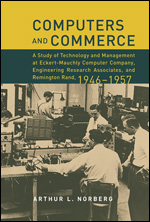 Norberg,
Arthur L. Computers and Commerce: A Study of
Technology and Management at Eckert-Mauchly Computer Company,
Engineering Research Associates, and Remington Rand, 1946-1957.
MIT Press 2005.
Norberg,
Arthur L. Computers and Commerce: A Study of
Technology and Management at Eckert-Mauchly Computer Company,
Engineering Research Associates, and Remington Rand, 1946-1957.
MIT Press 2005.
Oldfield, H.R. "General Electric enters the computer business--revisited." Annals of the History of Computing 17 #4 (Winter 1995): 46-55. <UMN>
Pugh, Emerson W. Memories that shaped an industry: decisions leading to IBM System/360. Cambridge: MIT Press, 1984.
Pugh, Emerson W. Building IBM: shaping an industry and its technology. Cambridge: MIT Press, 1995.
Stern, Nancy B. From ENIAC to UNIVAC: An Appraisal of the Eckert-Mauchly Computers. Bedford, Mass.: Digital Press, 1981.Yates, JoAnne. 2005. Structuring the Information Age: Life Insurance and Technology in the Twentieth Century. Baltimore: Johns Hopkins University Press.
Yost, Jeffrey R. A Bibliographic Guide to Resources in Scientific Computing, 1945-1975. Greenwood Press, 2002.
 Akera, Atsushi.
Calculating a Natural World: Scientists, Engineers, and
Computers During the Rise of U.S. Cold War Research.
MIT Press 2006 <MIT
Press>
Akera, Atsushi.
Calculating a Natural World: Scientists, Engineers, and
Computers During the Rise of U.S. Cold War Research.
MIT Press 2006 <MIT
Press>
Annals of the History of Computing. Special issue on SAGE vol. 5 #4 (1983). <UMN>
Aspray, William, and Bernard O. Williams. 1994. "Arming American Scientists: NSF and the Provision of Scientific Computing Facilities for Universities, 1950-1973." Annals of the History of Computing 16(4):60-74. <UMN>
Baum, Claude. 1981. The System Builders: The Story of SDC. Santa Monica: System Development Corporation.
Borning, Alan "Computer System Reliability and Nuclear War." Communications of the ACM 30 #2 (February 1987): 112-131 <WWW> (Oct. 2003)
"on October 5, 1960, the warning system at NORAD indicated that the United States was under massive attack by Soviet missiles with a certainty of 99.9 percent. It turned out that the BMEWS radar in Thule, Greenland, had spotted the rising moon. Nobody had thought about the moon when specifying how the system should act."Davis, N. C. and S. E. Goodman. "The Soviet Bloc's Unified System of Computers." ACM Computing Surveys 10 #2 (June 1978): 93-122. <WWW> (Oct. 2003) [On the Soviet's reverse engineering the IBM System/360]
Edwards, Paul N. The Closed World: Computers and the politics of discourse in Cold War America. Cambridge: MIT Press, 1996.
Flamm, Kenneth. 1988. Creating the Computer: Government, Industry and High Technology. Washington: Brookings Institution.
Forman, Paul. "Behind Quantum Electronics: National Security as Basis for Physical Research in the United States, 1940-1960." Historical Studies in the Physical and Biological Sciences 18 (1985): 149-229.
Hughes, Agatha C., and Thomas P. Hughes,
eds. Systems, Experts, and Computers: The Systems
Approach in Management and Engineering, World War II and After.
Cambridge: MIT Press, 2000
Hughes, Thomas P. 1998. Rescuing
Prometheus: The Story of the Mammoth Project Sage, ICBM,
Arpanet and Boston's Central Artery/Tunnel That Created New
Styles of Management. Pantheon. [case studies of SAGE bomber
defense, Atlas missile, ARPANET, and Boston's Central Artery
projects]
IBM's "On Guard" 1956 video at youtube
(10 min.) | part
2 (2 min.)
Jacobs, John F. The SAGE Air Defense System: A Personal History. MITRE Corporation, 1986.
Kahn, David. 1967. The Codebreakers: The Story of Secret Writing. Macmillan, New York.
Leslie, Stuart W. 1993. The Cold War and American Science: The Military-Industrial-Academic Complex at MIT and Stanford. New York: Columbia University Press. [available online as <ACLS Humanities Book>]
Mindell, David
A. Digital Apollo: Human and Machine in Spaceflight.
Cambridge: MIT Press 2008.
Misa, Thomas J. "Military Needs, Commercial Realities, and the Development of the Transistor, 1948-1958," in Merritt Roe Smith (ed.), Military Enterprise and Technological Change (MIT Press, 1985), pp. 253-87.
Misa, Thomas J. Digital
State: The Story of Minnesota's Computing Industry.
University of Minnesota Press, 2013. <UMN>
Noble, David F. 1984. Forces of Production: A Social History of Industrial Automation. New York: Knopf.
Norberg, Arthur L., and Judy E. O'Neill. 1996. Transforming Computer Technology: Information Processing for the Pentagon, 1962-1986. Baltimore: Johns Hopkins University Press.
Redmond, Kent C. and Thomas M. Smith. 1980. Project Whirlwind: The History of a Pioneer Computer. Bedford, Mass.: Digital Press. [see also Redmond & Smith 1980 on Whirlwind; and Ullmann 2014 on AN FSQ-7]
Rees, Mina. "The Computing Program of the Office of Naval Research, 1946-1953." Annals of the History of Computing 4 #2 (1982) 102-120; reprinted in Communications of the ACM 30 #10 (October 1987): 832 - 848. <WWW> (Oct. 2003)
Association for Computing Machinery (ACM) SIGPLAN. 1978. A History of Programming Languages: Proceedings of the ACM Conference on Programming Languages. Academic Press, Los Angeles, Calif.
Backus, John. 1979. "The History of FORTRAN I, II, and III." Annals of the History of Computing 1 #1 (Jan.-March 1979): 21-37. <UMN>
 Campbell-Kelly,
Martin. From Airline Reservations to Sonic the
Hedgehog: A History of the Software Industry. MIT
Press, 2003. [the first book-length study
of the software industry: software contractors and programming
service providers in the 1950s; corporate software products in
the 1960s; personal-computing software in the 1980s --- e.g.
FORTRAN, COBOL, SDC, SAGE and SABRE, IBM System/360, Gates and
Microsoft]
Campbell-Kelly,
Martin. From Airline Reservations to Sonic the
Hedgehog: A History of the Software Industry. MIT
Press, 2003. [the first book-length study
of the software industry: software contractors and programming
service providers in the 1950s; corporate software products in
the 1960s; personal-computing software in the 1980s --- e.g.
FORTRAN, COBOL, SDC, SAGE and SABRE, IBM System/360, Gates and
Microsoft]
Campbell-Kelly, Martin. "Number Crunching
without Programming: The Evolution of Spreadsheet Usability."
IEEE Annals of the History of Computing 29 no. 3 (2007):
6-19 <UMN>
Collins H.M. Artificial Experts: Social
Knowledge and Intelligent Machines. MIT Press, 1990.
Ensmenger, Nathan. The Computer Boys Take Over: Computers, Programmers, and the Politics of Technical Expertise. MIT Press, 2010.
Ensmenger, Nathan.
"Is chess the drosophila of artificial intelligence? A social
history of an algorithm." Social Studies of Science 42
no. 1 (2012): 5-30.
Franchi,
Stefano, and Güven Güzeldere, eds.
Mechanical Bodies, Computational Minds: Artificial
Intelligence from Automata to Cyborgs. MIT Press,
2005.
Haigh, Thomas. "Remembering the Office of
the Future: The Origins of Word Processing and Office
Automation." IEEE Annals of the History of Computing 28 no.
4 (2006): 6-31 <UMN>
Hashagen, Ulf,
Reinhard Keil-Slawik, and Arthur L. Norberg, eds. History of
Computing: Software Issues (Berlin/New York: Springer,
2002)
Hsu, Feng-Hsiung. Behind Deep
Blue: Building the Computer that Defeated the World Chess
Champion. Princeton University Press, 2004.
McCarthy, John. 1981. "History of Lisp," in Richard Wexelblat, ed., History of Programming Languages. Academic Press, New York. [available online at <www-formal.stanford.edu/jmc/history/lisp/lisp.html>]
MacKenzie, Donald. Mechanizing Proof: Computing, Risk, and Trust. MIT Press, 2001.
Mahoney, Michael S. "What Makes the History of Software Hard." IEEE
Annals of the History of Computing 30 no. 3 (July-Sept. 2008):
8-18.
Nilsson, Nils J. The Quest for Artificial Intelligence. Cambridge University Press, 2009.
Priestley, Mark. A Science of
Operations: Machines, Logic and the Invention of Programming.
Spring, 2011.
Roland, Alex, and Philip Shiman. Strategic Computing: DARPA and the Quest for Machine Intelligence, 1983-1993. Cambridge: MIT Press, 2002.
Wexelblat, Richard, ed. History of
Programming Languages. Academic Press, New York, 1981.
Campbell-Kelly, Martin, and Daniel D.
Garcia-Swartz. "Economic Perspectives on the History of the
Computer Time-Sharing Industry, 1965-1985." Annals of the
History of Computing 30 #1 (Jan.-March
2008): 16-36. <UMN>
Cortada, James W.
The Digital Hand. New York: Oxford University
Press, 2004-8.
Greenstein, Shane M. "Lock-in and the costs of switching mainframe computer vendors in the U.S. federal government in the 1970s." Annals of the History of Computing 17 #3 (Fall 1995): 58-66. <UMN>Volume 1: How Computers Changed the Work of American Manufacturing, Transportation, and Retail Industries
Volume 2: How Computers Changed the Work of American Financial, Telecommunications, Media, and Entertainment Industries
Volume 3: How Computers Changed the Work of American Public Sector Industries
Pardo-Guerra, J. P. "Creating flows of
interpersonal bits: The automation of the London Stock Exchange,
c.1955-90." Economy and
Society 39 (2010): 84-109.
Pugh, Emerson W., Lyle R. Johnson, and John H. Palmer. IBM's 360 and early 370 systems. Cambridge: MIT Press, 1991.
Stearns, David L. Electronic Value Exchange: Origins of the VISA Electronic Payment System. Springer, 2011.
Usselman, Steven W. "IBM and Its Imitators: Organizational Capabilities and the Emergence of the International Computer Industry." Business and Economic History 22 #2 (Winter 1993): 1-35. <WWW> (Sept. 2003)
Yost, Jeffrey R. The IBM Century: Creating the IT Revolution. IEEE Computer Society Press, 2011.Amazon: This unique volume brings together fascinating memoirs of key IBM engineers and managers of the past 100 years -- from Walter Jones, who started as a sales engineer in 1912 and rose through the ranks for three decades, to Cuthbert Hurd, James Birkenstock, Bob Evans, John Backus, Watts Humphrey, and others who led IBM to supremacy in digital computing and software. It details punch card tabulation, IBM’s entrance into computing, and the transformative IBM hardware (IBM 650, IBM 1401, System/360) and software (FORTRAN, SABRE, IMS) that changed the world. The IBM Century contains an IBM timeline, a comprehensive IBM annotated bibliography, and a new introductory essay that characterizes IBM's 100-year history and contextualizes each of the memoirs.
Aspray, William. "The Intel 4004 Microprocessor: What constituted invention?" Annals of the History of Computing 19 #3 (1997): 4-15. <UMN>
Bassett, Ross Knox. To the Digital Age: Research Labs, Start-Up Companies, and the Rise of MOS Technology. Johns Hopkins Univ. Press, 2002.
Braun, Ernest, and Stuart Macdonald. 1982. Revolution in Miniature: The History and Impact of Semiconductor Electronics. Cambridge University Press; 2nd ed.
Gray, G.T., and R.Q. Smith. "Sperry Rand's third-generation computers 1964-1980." Annals of the History of Computing 23 #1 (2001): 3-16. <UMN>
Harrar, George. The Ultimate Entrepreneur: The Story of Ken Olsen and Digital Equipment Corporation (Chicago: Contemporary Books, 1988).
Jackson, Tim. Inside Intel: Andy Grove and the rise of the world's most powerful chip company. New York, N.Y.: Dutton, 1997.
Jones, Douglas W. "The Digital Equipment Corporation PDP-8" <www.cs.uiowa.edu/~jones/pdp8/> (Aug. 2007) [wide-ranging WWW site with links to FAQs, programmers manuals, a brief history]
Kidder, Tracy. 1981. The Soul of a New Machine. Boston: Little, Brown; reprinted Back Bay Books, 2000. [wonderful portrait of Data General, a once-great mini-computer company]
Malone, Michael S. 1995. The Microprocessor: A Biography. New York: Springer-Verlag.
Mollick, Ethan. "Establishing Moore's
Law." IEEE Annals of the History of Computing 28
#3 (July-Sept. 2006): 62-75. <UMN>
Morris, P.R. A History of the World Semiconductor Industry (London: P. Peregrinus/Institution of Electrical Engineers, 1990).
Noyce, R.N., and M.E. Hoff, "A History of Microprocessor Development at Intel." IEEE Micro 1 #1 (Feb. 1981): 8-21.
Pearson, Jamie Parker. Digital at Work (Digital, 1992) [history of the Digital Equipment Company]
Schein, Edgar H. DEC Is Dead, Long Live DEC: The Lasting Legacy of Digital Equipment Corporation. Berrett-Koehler Publishers, 2003.
Thomas, P.A.V. "Solidac: an early
minicomputer for teaching purposes." Annals of the
History of Computing 15 #4 (1993): 79-83. <UMN>
Atkinson, Bill, and Andy Hertzfeld, oral history at Computer
History Museum (June 8, 2004) <www.computerhistory.org/collections/accession/102658007>
Bardini, Thierry. Bootstrapping: Douglas Engelbart, coevolution, and the origins of personal computing. Stanford University Press, 2000.
Chposky, James, and Ted. Blue Magic: the people, power, and politics behind the IBM personal computer. New York, NY: Facts on File, 1988.
Cusumano, Michael
A. Microsoft Secrets: How the World's Most Powerful
Software Company Creates Technology, Shapes Markets and
Manages People. New York: Free Press, 1998.
Freiberger, Paul, and Michael Swaine. Fire in the Valley: The making of the personal computer. New York: McGraw-Hill, 2000. 2nd ed.
Guterl, Fred. "Design Case History: Apple's Macintosh." IEEE Spectrum (Dec. 1984): 34-43. <WWW> (Sept. 2003)
Grossman, Wendy (ed.). 1997. Remembering the Future: Interviews from Personal Computer World. Springer Verlag.
Hiltzik, Michael. Dealers of Lightning: Xerox PARC and the Dawn of the Computer Age. New York: Harper, 1999.
Jobs, Steve [Smithsonian Institution oral history 1995] <americanhistory.si.edu/csr/comphist/sj1.html>
Johnson, Steven. Interface Culture (1997) chapter 2: "Desktop" <WWW> (Sept. 2003)
Levy, Steven. 1994. Insanely Great: The Life and Time of Macintosh, the computer that changed everything. New York: Viking. [see also Guterl (1984).]
Linzmayer, Owen W. Apple Confidential: The Real Story of Apple Computer, Inc. No Starch Press, 1999.
"Making the Macintosh: Technology and
Culture in Silicon Valley" <library.stanford.edu/mac>
(Jan. 2009)
Malone, Michael. Infinite loop: how [Apple] the world's most insanely great computer company went insane. New York: Currency/Doubleday, 1999.
Markoff, John. What the Dormouse
Said: How the Sixties Counterculture Shaped the Personal
Computer Industry. New York: Viking Penguin, 2005
Moritz, Michael. The little kingdom: the private story of Apple Computer. New York: Morrow, 1984.
Myer, Brad "All the Widgets" (ACM SIGCHI
video [1990] on interactive screen techniques) <vimeo.com/61556918>
Sloan MouseSite (on Douglas Engelbart) <sloan.stanford.edu/mousesite/>
Sumner, James. "What Makes a PC? Thoughts on Computing Platforms, Standards, and Compatibility" Annals of the History of Computing 29 #2 (April-June 2007): 88. <UMN>
Turner, Fred. From Counterculture
to Cyberculture: Stewart Brand, the Whole Earth Network, and
the Rise of Digital Utopianism. University Of
Chicago Press, 2006.
Waldrop, M. Mitchell. The Dream Machine: J.C.R. Licklider and the Revolution That Made Computing Personal. Penguin, 2002.
Berlin, Leslie. The Man Behind the Microchip: Robert Noyce and the Invention of Silicon Valley. Oxford University Press, 2005.
Gillmor, C. Stewart. Fred Terman at Stanford: Building a Discipline, a University, and Silicon Valley. Stanford: Stanford University Press, 2004.
Jackson, Tim. Inside Intel: Andy Grove and the rise of the world's most powerful chip company. New York, N.Y.: Dutton, 1997.
Kaplan, David A. The Silicon Boys and Their Valley of Dreams. New York: Perennial, 2000.
Kidder, Tracy. 1981. The Soul of a New Machine. Boston: Little, Brown. [wonderful portrait of Data General, a once-great computer company]
Hiltzik, Michael. Dealers of Lightning: Xerox PARC and the Dawn of the Computer Age. New York: Harper, 1999.
 Lecuyer, Christophe. Making Silicon
Valley: Innovation and the Growth of High Tech, 1930-1970.
MIT Press, 2005. <MIT
Press>
Lecuyer, Christophe. Making Silicon
Valley: Innovation and the Growth of High Tech, 1930-1970.
MIT Press, 2005. <MIT
Press>
Leslie, Stuart W. 1993. The Cold War and American Science: The Military-Industrial-Academic Complex at MIT and Stanford. New York: Columbia University Press. [available online as <ACLS Humanities Book>]
Lowen, Rebecca S. Creating the Cold War University: The Transformation of Stanford. Berkeley: University of California Press, 1997.
McKendrick, David G., Richard F. Doner, Stephan Haggard. From Silicon Valley to Singapore: Location and Competitive Advantage in the Hard Disk Drive Industry. Stanford Univ. Press, 2000.
Noyce, R.N., and M.E. Hoff, "A History of Microprocessor Development at Intel." IEEE Micro 1 #1 (Feb. 1981): 8-21.
O'Mara, Margaret Pugh. Cities of Knowledge:
Cold War Science and the Search for the Next Silicon Valley.
Princeton University Press, 2004.
Packard, David. The HP way: How Bill Hewlett and I built our company. New York: HarperBusiness, 1996.
Riordan, Michael, and Lillian Hoddeson. 1997. Crystal Fire: The Birth of the Information Age. New York: Norton. [invention of transistor at Bell Labs: Schockley's move to Palo Alto, Fairchild Semiconductor]
Rogers, Everett M. & Judith K. Larsen. Silicon Valley fever: growth of high-technology culture. New York: Basic Books, 1984.
Saxenian, Annalee. Regional
Advantage: Culture and Competition in Silicon Valley and
Route 128. Harvard Univ. Press, 1996.
"Secret History of Silicon
Valley" <www.youtube.com>
[Steve Blank discusses the
military's role in building what became Silicon Valley, at
a Google TechTalk lecture] (Dec. 2007)
Silicon Valley History Online
<www.siliconvalleyhistory.org>
database
with
historic
photos
of
agriculture,
transportation,
urban
life,
non-/famous
people,
technology
-- Intel chips
"Triumph of the Nerds" (PBS 1996):
Zachary, G. Pascal. Endless Frontier: Vannevar Bush, Engineer of the American Century. Cambridge: MIT Press, 1999; orig. NY: Free Press, 1997.
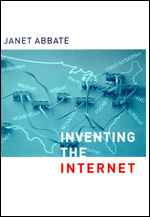 Abbate,
Janet. Inventing the Internet. MIT Press,
1999.
Abbate,
Janet. Inventing the Internet. MIT Press,
1999.
Aspray, William,
and
Paul E. Ceruzzi, eds. The Internet and American Business.
MIT Press, 2008 <MIT
Press> [TM
review]
Berners-Lee, Tim. "Web Architecture from 50,000 Feet." <www.w3.org/DesignIssues/Architecture.html> (July 2001)
Berners-Lee, Tim. "Realising the Full Potential of the Web." <www.w3.org/1998/02/Potential.html> (July 2001)
Berners-Lee, Tim. Weaving the Web. New York: HarperBusiness, 1999.
Berners-Lee, Tim, James Hendler, and Ora Lassila, "The Semantic Web," Scientific American (May 2001) <www.sciam.com/2001/0501issue/0501berners-lee.html> (August 2001).
Brody, Herb. "The Web Maestro: An Interview with Tim Berners-Lee." Technology Review (July 1996): 34-40.
Burg, Urs von. The Triumph of Ethernet: Technological Communities and the Battle for the LAN Standard. Stanford University Press, 2001.
Ceruzzi, Paul E. Internet Alley: High Technology in Tysons Corner, 1945-2005. MIT Press, 2008 <MIT Press>Clark, Jim. Netscape time: the making of the billion-dollar start-up that took on Microsoft. New York: St. Martin's Press, 1999.
Cortada, James W. "Studying the Role of IT
in the Evolution of American Business Practices: A Way
Forward." Annals of the History of Computing 29 #4
(Oct.-Dec. 2007): 28-39. <UMN>
Edwards, Paul
N. A Vast Machine: Computer Models, Climate Data, and the
Politics of Global Warming. MIT Press, 2010.
Feenberg, Andrew, and Norm Friesenm, eds. (Re)inventing
the Internet: Critical Case Studies.
Rotterdam/Boston: Sense 2012
Frana, Phil. "Before the Web there was Gopher." Annals of the History of Computing 26 #1 (Jan-Mar 2004): 20-41. <UMN>
Griset, Pascal and Valérie Schafer, Hosting the World Wide Web
Consortium for Europe: from CERN to INRIA. History and
Technology 27 #3 (2011):
353-370. <DOI>
Hafner, Katie, and Matthew Lyon. 1996. Where Wizards Stay Up Late: The Origins of the Internet. Simon & Schuster.
Ito, Mizuko, Daisuke Okabe and Misa Matsuda, eds. Personal, Portable, Pedestrian: Mobile Phones in Japanese Life. MIT Press 2005 <MIT Press>Johnston, Jessica.
Technological Turf Wars: A Case Study of the Computer
Antivirus Industry. Temple University Press, 2008.
Kesan, Jay P. and Rajiv C. Shah, "Fool Us Once Shame On You - Fool Us Twice Shame On Us: What We Can Learn From the Privatizations of the Internet Backbone Network and the Domain Name System," Washington University Law Quarterly 79 (2001): 89-220. <papers.ssrn.com/sol3/papers.cfm?abstract_id=260834> (Sept. 2003)
Kesan, Jay P. and Rajiv C. Shah, "Deconstructing Code," Yale Journal of Law
& Technology 6 (2003-2004): 277-389.
Kesan, Jay P. and Rajiv C. Shah, "Shaping Code," Harvard Journal of Law &
Technology 18, no. 2 (Spring 2005): 319-399.
Kirkpatrick, David.
The Facebook Effect: The Inside Story of the Company That Is
Connecting the World. Simon & Schuster, 2010.
Leiner, Barry M., Vinton G. Cerf, David D. Clark, Robert E. Kahn, Leonard Kleinrock, Daniel C. Lynch, Jon Postel, Larry Roberts, and Stephen Wolff. A Brief History of the Internet. [online at <www.isoc.org/internet/history/brief.shtml> version 3.3.2 (Dec. 2003); see also Internet Society's "Histories of the Internet"]
Quittner, Joshua and Michelle Slatalla. Speeding the Net: The inside story of Netscape and how it challenged Microsoft. New York: Atlantic Monthly Press, 1998.
Partridge, Craig. "The Technical Development of Internet Email" Annals of the History of Computing 30 #2 (April-June 2008): 3-29. <UMN>
Russell, Andrew L. "'Rough Consensus and Running Code' and the Internet-OSI Standards War." IEEE Annals of the History of Computing 28 #3 (July-Sept. 2006): 48-61. <UMN>SRI International. 1997. "The Internet," Chapter IV in The Role of NSF's Support of Engineering in Enabling Technological Innovation. SRI International, Arlington, Va. [online at <unix.sri.com/policy/stp/techin/inter1.html>]
Torvalds, Linus, and David Diamond. Just for Fun: The Story of an Accidental Revolutionary. HarperBusiness, 2001.
Turkle, Sherry. Life on the Screen: Identify in the Age of the Internet. New York: Simon & Schuster, 1995.
Ullman, Ellen. 1997. Close to the Machine. San Francisco: City Lights. [Computer programmers--Biography]
Waldrop, M. Mitchell. The Dream Machine: J.C.R. Licklider and the Revolution That Made Computing Personal. Penguin, 2002.
Weber, Steven.
The Success of Open
Source. Harvard University Press, 2004.
Yost, Jeffrey R. "Computers and the Internet: Braiding Irony, Paradox, and Possibility," in Carroll Pursell, ed. Companion to American Technology. Oxford: Blackwell, 2005, pp. 340-360
Abbate, Janet. "Women and Gender in the History of
Computing." [intro to special issue] IEEE Annals of the History of
Computing 25 no. 4 (Oct-Dec 2003): 4-8.
Adams, Alison. "Constructions of Gender in the History of
Artificial Intelligence." IEEE
Annals of the History of Computing 18 no. 3 (Fall
1996): 47-53.
Adam, Alison. "Who knows how? Who knows that? Feminist
Epistemology and Artificial Intelligence." Proceedings of the IFIP TC9/WG9.1
Fifth International Conference on Woman, Work and
Computerization: Breaking Old Boundaries - Building New Forms
(2-5 July 1994): 143-156 <ACM>
Almstrum, V. L., Barker, L. J., Owens, B. B., Adams, E., Aspray,
W., Dale, N. B., Dann, W., Lawrence, A., and Schwartzman, L. 2005.
"Building a sense of history: narratives and pathways of women
computing educators." SIGCSE
Bull. 37 no. 4 (Dec. 2005): 173-189. <DOI>
Aspray, William, and Donald Beaver. "Marketing The Monster:
Advertising Computer Technology." Annals of the History of Computing 8, no. 2
(1986): 127-143. <IEEE>
Beckwith, L., M. Burnett, V. Grigoreanu, and S. Wiedenbeck.
"Gender HCI: What About the Software?" Computer 39 no. 11 (Nov. 2006):
97-101. DOI: 10.1109/MC.2006.382
Berg, Anne-Jorunn and Merete Lie. “Feminism and Constructivism:
Do Artifacts Have Gender?” Science,
Technology,
and Human Values 20 (Summer 1995): 332-51. <JSTOR>
Berg, Anne-Jorunn. Digital
Feminism. Dragvoll, Norway: Senter for teknologi og
samfunn, 1996.
Beyer, S., K. Rynes, and S. Haller. "Deterrents to Women
taking Computer Science Courses." IEEE Technology and Society Magazine 23 no.
1 (Spring 2004): 21-28.
Bix, A.S. "'Engineeresses' Invade Campus: Four Decades of
Debate over Technical Coeducation." IEEE Technology and Society Magazine
19 no. 1 (Spring 2000):20-26. DOI: 10.1109/44.828560
Bray, Francesca. "Gender and Technology." Annual Review of Anthropology
36 (2007): 37-53. <anthro.annualreviews.org>
DOI:10.1146/annurev.anthro.36.081406.094328
Bresnahan, Timothy F. "Computerisation and Wage Dispersion:
An Analytical Reinterpretation." The Economic Journal 109
no. 456: Features (June 1999): F390-F415. JSTOR
Britton, Dana M. "The Epistemology of the Gendered
Organization." Gender and Society 14 no. 3 (June 2000):
418-434. JSTOR
Camp, T., and D. Gurer. "Women in computer science: where
have we been and where are we going?" 1999 International
Symposium on Technology and Society, 1999. Women and Technology:
Historical, Societal, and Professional Perspectives. Proceedings.
(29-31 July 1999): 242-244. DOI:
10.1109/ISTAS.1999.787339
Justine Cassell and Henry Jenkins, eds. From Barbie to Mortal Kombat: Gender
and Computer Games. Cambridge: MIT Press, 1998 <MIT
Press> [see Kafai et al. 2008]
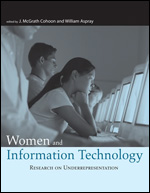 Cohoon,
J. McGrath, and William Aspray. Women and Information
Technology: Research on Underrepresentation.
Cambridge: MIT Press, 2006.
Cohoon,
J. McGrath, and William Aspray. Women and Information
Technology: Research on Underrepresentation.
Cambridge: MIT Press, 2006.
Clegg, Sue, Deborah Trayhurn, and Andrea Johnson. "Not Just
for Men: A Case Study of the Teaching and Learning of Information
Technology in Higher Education." Higher Education 40 no. 2
(Sept. 2000): 123-145. JSTOR
Clegg, Sue, and Deborah Trayhurn. "Gender and Computing:
Not the Same Old Problem." British
Educational Research Journal 26 no. 1 (Feb.
2000):75-89. JSTOR
Cockburn, Cynthia. Machinery
of Dominance: Women, Men and Technical Know-how.
London/Dover NH: Pluto Press, 1985.
Cockburn, Cynthia, and Susan Ormrod. Gender and Technology in the Making.
London/Thousand Oaks CA: Sage, 1993.
Cooper, Joel, and Kimberlee D. Weaver. Gender and Computers: Understanding
the Digital Divide. Lawrence Erlbaum, 2003.
Coopersmith, Jonathan. “Does Your Mother Know What You Really Do?
The Changing Nature and Image of Computer-Based Pornography.” History and Technology 22
(2006): 1-25.
Creager, Angela N.H., Elizabeth Lunbeck & Londa Schiebinger,
eds. Feminism in
Twentieth-century Science, Technology, and Medicine.
Chicago:
University of Chicago Press, 2001.
Downey, Gary L. The Machine in
Me: An Anthropologist Sits among Computer Engineers. New
York: Routledge, 1998.
Downey, Greg. "Virtual Webs, Physical Technologies, and Hidden
Workers: The Spaces of Labor in Information Internetworks."
Technology and Culture 42
no. 2 (April 2001): 209-235. MUSE
Downey, Greg. "Constructing 'Computer-Compatible'
Stenographers: The Transition to Real-time Transcription in
Courtroom Reporting." Technology
and Culture 47 no. 1 (January 2006): 1-26. MUSE
Downs, Laura. Manufacturing Inequality: Gender Division
in the French and British Metalworking Industries, 1914-1939.
Ithaca:
Cornell University Press, 1995. [13-page
introduction surveys the literature.]
Edwards, Paul N. "The Army and the Microworld: Computers
and the Politics of Gender Identity." Signs 16 no. 1: From
Hard Drive to Software: Gender, Computers, and Difference (Autumn
1990): 102-127. JSTOR
Eglash, Ron. "Race, Sex, and Nerds: From Black Geeks to
Asian American Hipsters." Social
Text 20 no. 2 (Summer 2002): 49-64. MUSE
Estrin, T. "Women's Studies and Computer Science: Their
Intersection." IEEE Annals of
the History of Computing 18 no. 3 (Fall 1996):
43-46.
Faulkner, Wendy. "The Power and the Pleasure? A Research
Agenda for 'Making Gender Stick' to Engineers." Science,
Technology, & Human Values 25 no. 1 (Winter 2000):
87-119. JSTOR
Faulkner, Wendy. "Dualisms, Hierarchies and Gender in
Engineering." Social Studies of Science 30 no. 5 (Oct.
2000): 759-792. JSTOR
Fitzsimons, Annette. "Programming Sexism" (ch.4) and "Discourses
of Science and Technology" (ch.7) in Gender as a Verb: Gender
Segregation at Work. Aldershot: Ashgate, 2002.
Forsythe, Diana E. "New Bottles, Old Wine: Hidden Cultural
Assumptions in a Computerized Explanation System for Migraine
Sufferers." Medical Anthropology Quarterly 10 no. 4:
Critical and Biocultural Approaches in Medical Anthropology: A
Dialogue (Dec. 1996): 551-574. JSTOR
Fox, Mary Frank, Deborah Johnson, Sue V. Rosser,
eds., Women, Gender, and
Technology. Urbana: University of Illinois Press,
2006.
Friedman, Elisabeth J. "The Reality of Virtual Reality: The
Internet and Gender Equality Advocacy in Latin America." Latin American Politics &
Society 47 no. 3 (Fall 2005): 1-34. MUSE
Gere, Charlie. "Writing Cyberculture." Oxford Art
Journal 22 no. 1 (1999): 149-157. JSTOR
Reviewed Works:
Modest_Witness@Second_Millenium.FemaleMan_Meets_OncoMouse™ by Donna Haraway
Zeroes + Ones: Digital Women + the New Technoculture by Sadie Plant
The War of Desire and Technology at the Close of the Mechanical Age by Allucquere Rosanne Stone
NASA/TREK: Popular Science and Sex in America by Constance Penley
Ground Control by Susan Buck-Morss; Julian Stallabrass; Leonidas Donskis
Golumbia, David. "Computation, Gender, and Human Thinking."
differences: A Journal of
Feminist Cultural Studies 14 no. 2 (Summer 2003):
27-48. MUSE
Goyal, A. "Women in Computing: Historical Roles, the Perpetual
Glass Ceiling, and Current Opportunities." IEEE Annals of the History of
Computing 18 no. 3 (Fall 1996): 36-42.
Grier, David Alan. When
Computers were Human. Princeton: Princeton
University Press, 2005. <introduction>
Gurer, D.W. "Women's contributions to early computing at
the National Bureau of Standards." IEEE Annals of the History of Computing 18 no.
3 (Fall 1996): 29-35.
Gürer, D. 2002. "Women in computing history." SIGCSE Bull. 34 no. 2 (June
2002): 116-120. <DOI>
Hakken, David. "Computing and Social Change: New Technology and
Workplace Transformation, 1980-1990." Annual Review of
Anthropology Vol. 22 (1993): 107-132. JSTOR
Herring, Susan. “The Rhetorical Dynamics of Gender Harassment
On-line.” The Information
Society 15:3 (1999): 151-67.
Horowitz, Roger, ed. Boys and
Their Toys? Masculinity, Class, and Technology in America.
New
York: Routledge, 2001.
Hughes, D.M. "The Internet and Sex Industries: Partners in
Global Sexual Exploitation." Technology and Society Magazine 19 no. 1
(Spring 2000): 35-42. DOI: 10.1109/44.828562
Johnson N.F., Rowan L., Lynch J., "Construction of Gender in
Computer Magazine Advertisements: Confronting the Literature," Studies in Media and Information
Literacy Education 6 no. 1 (2006): <WWW>
Journal
of Women and Minorities in Engineering. www.begellhouse.com/journals/00551c876cc2f027.html
"publishes original, peer-reviewed papers that report
innovative ideas and programs for classroom teachers, scientific
studies, and formulation of concepts related to the education,
recruitment, and retention of under-represented groups in
science and engineering"
Jungck, Susan. "Viewing Computer Literacy through a
Critical, Ethnographic Lens" Theory into Practice 29 no.
4: Microcomputers in Context (Autumn, 1990): 283-289. JSTOR
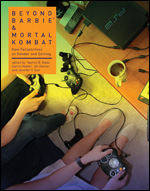 Kafai, Yasmin B., Carrie Heeter, Jill Denner, and
Jennifer Y. Sun, eds. Beyond
Barbie and Mortal Kombat: New Perspectives on Gender and Gaming.
Cambridge: MIT Press, 2008. <MIT
Press> [see Cassell supra]
Kafai, Yasmin B., Carrie Heeter, Jill Denner, and
Jennifer Y. Sun, eds. Beyond
Barbie and Mortal Kombat: New Perspectives on Gender and Gaming.
Cambridge: MIT Press, 2008. <MIT
Press> [see Cassell supra]
Keller, Evelyn Fox. Reflections on Gender and Science.
New Haven: Yale University Press, 1985.
Keller, Evelyn Fox. "Gender and Science: Origin, History,
and Politics." Osiris 10: Constructing Knowledge in the
History of Science (1995): 26-38. JSTOR
Kendall, Lori. "'The Nerd Within': Mass Media and the Negotiation
of Identity Among Computer-Using Men." The Journal of Men's Studies 7 no. 3 (1999):
353-69.
Kendall, Lori. "Nerd Nation: Images of Nerds in U.S. Popular
Culture." International Journal
of Cultural Studies 2 no. 2 (1999): 260-283.
Kendall, Lori. "'Oh No! I'm a Nerd!': Hegemonic Masculinity
on an Online Forum." Gender and Society 14 no. 2 (Apr.
2000): 256-274. JSTOR
Kraft, Joan F., and Jurg K. Siegenthaler. "Office
Automation, Gender, and Change: An Analysis of the Management
Literature." Science, Technology, & Human Values 14
no. 2 (Spring 1989): 195-212. JSTOR
Kramer, Pamela E., and Sheila Lehman. "Mismeasuring Women:
A Critique of Research on Computer Ability and Avoidance." Signs
16 no. 1: From Hard Drive to Software: Gender, Computers, and
Difference (Autumn 1990): 158-172. JSTOR
Lagesen, Vivian Anette. "The Strength of Numbers: Strategies to
Include Women into Computer Science." Social Studies of Science 37 (2007): 67-92.
Lagesen, Vivian Anette. "A Cyber-feminist Utopia?
Perceptions of gender and computer science among Malaysian
women computer science students." Department of Interdisciplinary
Studies of Culture, Norwegian University of Science and Technology
(NTNU) <WWW>
Lerman, Nina E., Arwen Palmer Mohun; Ruth Oldenziel. "The
Shoulders We Stand on and the View from Here: Historiography and
Directions for Research." Technology and Culture 38
no. 1, Special Issue: Gender Analysis and the History of
Technology (Jan. 1997): 9-30. JSTOR
Lerman, Nina, Ruth Oldenziel, and Arwen P. Mohun, eds. Gender and Technology: A Reader.
Baltimore: Johns Hopkins University Press, 2003.
Lie, Merete, ed. He, She and
IT Revisited: New Perspectives on Gender in the Information
Society. Oslo: Gylendal, 2003.
Light, Jennifer S. “The Digital Landscape: New Space for Women?”
Gender, Place, and Culture: A
Journal of Feminist Geography 2:2 (1995): 133-46.
Light, Jennifer S. "When Computers Were Women." Technology
and Culture 40 no. 3 (July 1999): 455-483. MUSE
Lipartito, Kenneth. "When Women Were Switches: Technology,
Work, and Gender in the Telephone Industry, 1890-1920." American
Historical Review 99 no. 4 (Oct. 1994): 1074-1111. JSTOR
Lohan, Maria, and Wendy Faulkner, "Masculinities and
Technologies," Men and
Masculinities 6 no. 4 (2004): 319-329.
Margolis, J., A. Fisher, and F. Miller, "Caring about
Connections: Gender and Computing." IEEE Technology and Society Magazine
18 no. 4 (Winter 1999-2000): 13-20.
Margolis, Jane, and Allan Fisher. Unlocking the
Clubhouse: Women in Computing. Cambridge: MIT
Press, 2002.
Matthews, Glenna. Silicon
Valley, Women, and the California Dream: Gender, Class, and
Opportunity in the Twentieth Century. Stanford
University Press, 2002. <SUP>
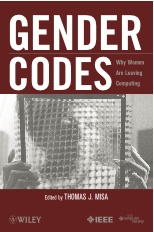 Misa,
Thomas J., ed. Gender Codes: Why Women Are Leaving Computing.
Wiley/IEEE Computer Society Press, 2010. <Amazon.com>
Misa,
Thomas J., ed. Gender Codes: Why Women Are Leaving Computing.
Wiley/IEEE Computer Society Press, 2010. <Amazon.com>
Nakhaie, M. Reza, and Robert M. Pike. "Social Origins,
Social Statuses and Home Computer Access and Use." Canadian
Journal of Sociology / Cahiers canadiens de sociologie 23
no. 4 (Autumn 1998): 427-450. JSTOR
Nelson, Donna. "National Analysis of Minorities in Science and
Engineering Facilities at Research Universities" [reports from
2002 and 2007] <WWW>
[Places computer science in the
larger context of engineering; assesses the effects of bias
and prestige in research and teaching universities.]
Oldenziel, Ruth. Making
Technology Masculine: Making Technology Masculine: Men, Women
and Modern Machines in America, 1870-1945.
Amsterdam: Amsterdam University Press, 1999.
Perry, Ruth, and Lisa Greber, "Women and Computers: An
Introduction." Signs 16 no. 1: From Hard Drive to
Software: Gender, Computers, and Difference (Autumn 1990):
74-101. JSTOR
Pursell, Carroll. “Domesticating Modernity: The Electrical
Association for Women, 1924-1986.” British Journal of the History of Science 32
(1999): 47-67.
Rathgeber, Eva M., and Edith Ofwona Adera. Gender and the Information
Revolution in Africa. Ottawa: International
Development Research Centre, 2000.
Robertson, Claire C. "Age, Gender, and Knowledge Revolutions in
Africa and the United States." Journal
of Women's History 12 no. 4 (Winter 2001): 174-183.
MUSE
Rosenzweig, Roy. "Wizards, Bureaucrats, Warriors, and
Hackers: Writing the History of the Internet." American
Historical Review 103 no. 5 (Dec. 1998): 1530-1552. JSTOR
Rosser, Sue Vilhauer. "Using POWRE to ADVANCE:
Institutional Barriers Identified by Women Scientists and
Engineers." NWSA Journal
16 no. 1 (Spring 2004): 50-78. MUSE
Rosser, Sue Vilhauer. "Through the Lenses of Feminist
Theory: Focus on Women and Information Technology."
Frontiers: A Journal of Women
Studies 26 no. 1 (2005): 1-23. MUSE
Schleiner, Anne-Marie. "Does Lara Croft Wear Fake Polygons?
Gender and Gender-Role Subversion in Computer Adventure Games." Leonardo
34 no. 3 (2001): 221-226. JSTOR
Scott, Joan W. "Gender: A Useful Category of Historical
Analysis." American Historical Review 91 no. 5 (Dec.
1986): 1053-1075. JSTOR
Scott, Tony, Michael Cole, and Martin Engel. "Computers and
Education: A Cultural Constructivist Perspective." Review of
Research in Education 18 (1992): 191-251. JSTOR
Scott-Dixon, Krista. Doing
It:
Women Working In Information Technology. Sumach
Press, 2004.
Shell-Gellasch, Amy. "Mina Rees and the Funding of the
Mathematical Sciences." American Mathematical Monthly
109 no. 10 (Dec. 2002): 873-889. JSTOR
Stanley, Autumn. Mothers and Daughters of
Invention: Notes for a Revised History of Technology.
Metuchen NJ: Scarecrow Press, 1993.
Stepulevage, L. "Computer-based Office Work: Stories of
Gender, Design, and Use." IEEE
Annals of the History of Computing 25 no. 4 (Oct-Dec
2003): 67-72.
Stein, Dorothy. Ada: A Life and a Legacy.
Cambridge: MIT Press, 1985. [Lovelace,
Ada King, 1815-1852.]
Temple Dennett, J. "Addressing Bias in Clip Art Provided
with Popular Software." IEEE
Transactions on Professional Communication 41 no. 4
(Dec. 1998): 270-273. DOI: 10.1109/47.735369
Travers, Ann. "Parallel Subaltern Feminist Counterpublics
in Cyberspace." Sociological Perspectives 46 no. 2 (Summer
2003): 223-237. JSTOR
Valian, Virginia. "Women at the top in science - and
elsewhere." In S. Ceci and W. Williams, eds. Why Aren't More
Women in Science? Washington DC: American Psychological
Association Press, 2006, pp. 27-37. <WWW>
[Examines the status of women in
many professions, and describes mechanisms such as 'gender
schemas' operating in many fields, including computer
science.]
Vehvilainen, M. "Gender and Computing in Retrospect: The
Case of Finland." IEEE
Annals of the History of Computing 21 no. 2 (April-June
1999): 44-45
Wajcman, Judy. "Reflections on Gender and Technology Studies: In
What State is the Art?" Social Studies of Science 30
no. 3 (June 2000): 447-464. JSTOR
Wajcman, Judy. TechnoFeminism.
Polity Press, 2004.
"Women in Computing." [special issue] IEEE Annals of the History of Computing 18 no. 3
(1996): 3-55.
"Women and Gender in the History of Computing" [special issue] IEEE Annals of the History of
Computing 25 no. 4 (1996): 4-72.
Wosk, Julie. Women and
the Machine: Representations from the Spinning Wheel to the
Electronic Age. Baltimore: Johns Hopkins University
Press, 2003.
Wyatt, Sally. "Non-users also matter: the construction of
users and nonusers of the Internet. In Oudshoorn & Pinch, eds.
How Users Matter: The
Co-Construction of Users and Technology. Cambridge: MIT
Press, 2003, pp. 67-80.
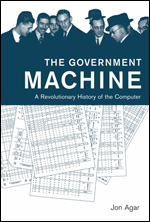 Agar, Jon. The
Government Machine: A Revolutionary History of the Computer.
Cambridge: MIT Press, 2003.
Agar, Jon. The
Government Machine: A Revolutionary History of the Computer.
Cambridge: MIT Press, 2003.Fitzpatrick, Anne, S. Berkovich, T.
Kazokova. "MESM and the Beginning of the Computer Era in the
Soviet Union." IEEE
Annals of the History of Computing 28 no. 3 (2006): 4-16
<UMN>
Flamm, Kenneth. 1988. Creating the Computer: Government, Industry and High Technology. Washington: Brookings Institution.
Gerovitch, Slava. From Newspeak to
Cyberspeak: A History of Soviet Cybernetics. Cambridge:
MIT Press, 2002
Hendry, John. Innovating for Failure: Government Policy and the Early British Computer Industry. Cambridge: MIT Press, 1990. [details ten years of effort by the NRDC to establish a British computer industry able to compete internationally, particularly with IBM]
Jiuchun, Zhang, and Zhang
Baichun. "Founding of the Chinese Academy of Sciences'
Institute of Computing Technology." IEEE Annals of the
History of Computing 29 no. 1 (2007): 16-33 <UMN>
McKendrick, David G., Richard F. Doner,
Stephan Haggard. From Silicon Valley to Singapore:
Location and Competitive Advantage in the Hard Disk Drive
Industry. Stanford Univ Press, 2000.
Medina, Eden. "Designing Freedom,
Regulating a Nation: Socialist Cybernetics in Allende’s Chile."
Journal of Latin American Studies 38 (2006): 571-606
Medina, Eden. Cybernetic Revolutionaries: Technology and
Politics in Allende’s Chile. MIT Press, 2011.
Morris, P.R. A History of the World Semiconductor Industry (London: P. Peregrinus/Institution of Electrical Engineers, 1990).
National Research Council. Funding a Revolution: Government Support for Computing Research. Washington, D.C.: National Academy Press, 1999 [available online at <www.nap.edu/readingroom/books/far/contents.html>]
Case Studies:
Okimoto, Daniel I., Takuo Sugano, and
Franklin B. Weinstein (eds.). Competitive Edge: The
semiconductor industry in the U.S. and Japan. Stanford:
Stanford University Press, 1984.
Rojas, Raul, and Ulf Hashagen, eds. The First Computers: History and Architectures. Cambridge: MIT Press, 2002. [architectures of the first computers built in the United States, Germany, England, and Japan]
Schlombs, Corinna. "Toward International
Computing History." IEEE Annals of the History of Computing 28
#1 (2006): 108 <UMN>
Vardalas, John N. The Computer Revolution in Canada: Building National Technological Competence. Cambridge: MIT Press, 2001.
Wilson, Robert W., Peter K. Ashton, Thomas
P. Egan. Innovation, competition, and government policy in
the semiconductor industry. Lexington, Mass.: Lexington
Books, 1980.